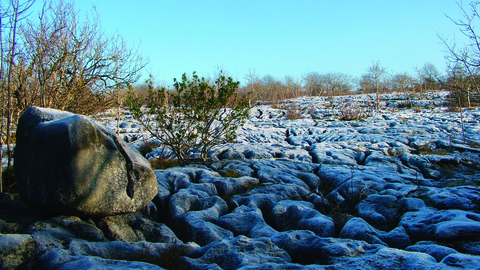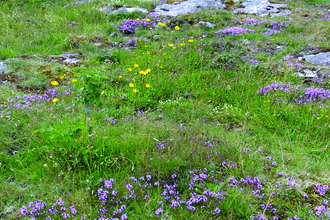
Limestone pavement at Hutton Roof Crags Nature Reserve
Hutton Roof Crags
Location
Know before you go
Dogs
When to visit
Opening times
Open all year roundBest time to visit
April to JulyAbout the reserve
Wildlife highlights
- A succession of butterflies can be seen from April – brimstone, green hairstreak and small tortoiseshell are the first to appear, then the eye-catching fritillaries, common blue, peacock and grayling are on the wing from May onwards.
- Unusual limestone pavement specialists such as dark-red helleborine, lily-of-the-valley, rigid buckler-fern, limestone fern and angular Solomon’s-seal in summer.
- In spring - In the more open areas you can find dark red helleborine, fly orchids and early purple orchids.
- In summer - hear birds such as willow warbler and skylark along with the resident nuthatch, great spotted woodpecker and woodcock.
- In autumn - the nature reserve is alive with flocks of long-tailed tits, redwing, fieldfare and mistle thrush.
- At any time of year explore the limestone pavement and take in the views.
- On the thinnest soil look out blue moor grass - with its silky blue flowers in April.
- Juniper is abundant both on the pavement and the grassland and there are lots of scrub areas. On thicker soil you will find bracken sometimes with bilberry and heather beneath.
What makes Hutton Roof Crags so special?
The limestone pavement is home to a number of specialist rare ferns and flowering plants, and the very thin limestone soil is ideal for dark-red helleborine and juniper to thrive.
Animals
In summer you will hear birds such as willow warbler and skylark, along with the resident birds such as nuthatch, greater spotted woodpecker and woodcock.
From April there is a succession of butterflies. First to appear are the small tortoiseshell and brimstone butterflies and the green hairstreak.
From May onwards there are fritillaries along with common blue, peacock and grayling.
Badgers, foxes and roe deer are frequently seen on the reserve.
History
Comprising the land known as Lancelot Clark Storth and Burton Fell, the nature reserve contains some of the best areas of limestone pavement in Britain.
Once wooded, the current mosaic of woodland, scrub, grassland and heath results from past clearance and grazing. Walls were built to create enclosures in the 19th century.
Reduced grazing pressure since the early 20th century has allowed trees and scrub to re-establish.
Only Park Wood and Pickles Wood have had continuous woodland cover since the medieval period.
Keeping it special
Today, management is aimed at maintaining areas of open grassland and pavement. Cattle have a vital role to play in helping maintain the rich diversity of flowering plants.
Coppicing takes place in the wooded area of Lancelot Clark Storth to provide breeding habitat for these species.
Recent history
Lancelot Clark Storth was purchased in 1978. Burton Fell was given to the Trust in 1992 by the New Zealand descendents of William Atkinson. Park Wood and Hutton Roof Common are leased from Natural England and Hutton Roof Parish Council respectively.
Getting here
By car:
From M6 junction 36 take A65 then A6070 towards Burton-in-Kendal. At the Clawthorpe Hall Business Centre take the left turn signed for Clawthorpe. Follow this for approx 1.5km/0.9 miles and park where bridleway is signed for Burton (SD 543 783). Follow bridleway across the field and into the wood until the reserve is reached (300m/330yds).
Additional parking next to other footpaths into the nature reserve are further along the road at SD 552 789 and SD 552 762.
By bicycle:
The reserve is 5km/2.5miles from Regional Route 90.
By public transport:
Buses run from Lancaster and Kendal to Burton-in-Kendal.
Watch 'Chasing Pavements' by film-maker Rachel Wegh Chasing Pavements from Rachel Wegh on Vimeo.
Species
Habitat
Contact us
Take a virtual tour of Hutton Roof Nature Reserve
Did you know?
The limestone rock was laid down in a warm shallo sea some 350 million years ago during the Carboniferous period.
Upcoming events at Hutton Roof Crags Nature Reserve
If there are any upcoming events at Hutton Roof Crags Nature Reserve we'll show them to you below.

Support our conservation work on this nature reserve,
and protect Cumbria's wildlife & wild places.







